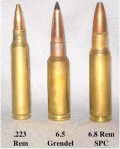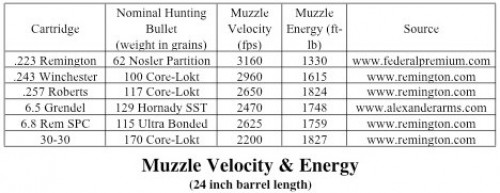Why the Fuss about the Grendel?
Conversations with my second son, an artillery captain in the Army, often inspire intriguing questions about weapons and ammunition. During one recent discussion he wondered, “With the long and successful history of the 5.56 NATO, why all the fuss over the 6.8 Remington SPC™ and the 6.5 Grendel™?”
We had a fair understanding of the military mission arguments but were thinking of the cartridges in terms of their recreational shooting qualities. Relatively flat trajectory over normal hunting distances coupled with several options for bullets weighing more than 100 grains piqued our interest in their utility as hunting cartridges.
A brief review of the military debate will help establish the underpinning of the recreational shooting opportunities: Several excellent articles already in print point have thoroughly explored the military and competition qualities of these three cartridges. The authors of these articles suggest that the current 6.8 Remington SPC™, 6.5 Grendel™, and 5.56 NATO debate apparently resulted from a high frequency of multiple hits failing to stop the targeted individual — particularly at the longer ranges encountered by Special Forces in Afghanistan during the early phases of the war on terror.
This apparent reduction in stopping power was likely caused by the more widespread use of the M4 with the 14.5” barrel coupled with the more frequent long-range (e. g., beyond 100 to 120 meters) engagements than in prior conflicts. In many engagements at the longer ranges, the M4 with ammunition available at that time very likely created wound ballistics not much beyond those caused by 22 long-rifle ammunition.
Given the field experiences and not just a little curiosity, members of the military firearms community started exploring alternatives to the standard 5.56 NATO. As a result, we have the 6.8 Remington SPC™, the 6.5 Grendel™, and the Mk262 Mod 0 and Mod 1 loads for the 5.56 NATO. The Mk262, with the 77-grain bullet, apparently satisfies the needs of M4 users in Afghanistan, but debate continues in some quarters. The “ideal military cartridge” debate will continue as both technology advances and combat experience drive changes in our primary service cartridge and weapon. This debate is normal in our society and will continue as has happened in every conflict we’ve engaged in. The good news is that this debate gives us two very interesting new cartridges to work with.
Both the 6.8 SPC™ and 6.5 Grendel™ were designed to work in the AR platform with straightforward replacement of existing parts (i. e., swap out upper assemblies). The AR platform has a large and growing number of users who understand and respect its capabilities. This younger generation, unlike those of us who were weaned on the 30-06 class of cartridges, understands the capability of the 5.56 NATO (.223) and sees the 6.8 Remington SPC™ and 6.5 Grendel™ as more powerful versions of their service rifle with good varmint and medium game potential, instead of merely overgrown varmint cartridges.
Let’s look first at the medium game application. The 6.5 Grendel™ and 6.8 Remington SPC™ are not in the same power class as cartridges like the .270 Winchester and the 30‑06. More deer, however, have been taken by the 30-30 Winchester than about any other existing cartridge. Other classic deer cartridges of less power than the big cartridges include the .243 Winchester and .257 Roberts in addition to the 30-30 Winchester. These cartridges have solid reputations as harvesters of this class of game and form a solid reference for comparison
The table compares these classic cartridges with the more recent .223 Remington occasionally used for deer hunting along with the much newer 6.5 Grendel™ and 6.8 Remington SPC™. The characteristics of the classics are shown with bullets of the type that forged their reputation. The most modern bullets add to their capabilities but we are more concerned with assessing adequacy of the new cartridges compared to classic experiences.
The 6.5 Grendel™ & 6.8 Remington SPC™ are within 5 per cent of the 30-30 and .257 Roberts, with about 1750 ft-lbs muzzle energy. The .223 Remington carries the smallest muzzle energy at about three-quarters of the others, reinforcing the view of the younger shooting community that the 6.5 Grendel™ and 6.8 Remington SPC™ are indeed more capable hunting rounds than the 5.56 NATO, their standard service cartridge.
###
Acknowledgements: This article would have been a lot less interesting and more confusing without the excellent advice and encouragement from Charlie Cutshaw, Alane Alchorn, and Randy Collins. Charlie in particular brought reports of recent combat experiences with the Mk262 to my attention. Thank you!




Leave a Reply
You must be logged in to post a comment.